Medical Science Case Study: Acute Appendicitis Diagnosis and Treatment
VerifiedAdded on 2020/05/11
|7
|1581
|65
Case Study
AI Summary
This case study presents the case of a 52-year-old woman, Emma Smith, experiencing acute abdominal pain, vomiting, and other symptoms indicative of acute appendicitis. The assignment details the patient's history, including the onset and characteristics of her pain, as well as her vital signs. It provides a provisional diagnosis of acute appendicitis, emphasizing the need for immediate care and management. The aetiology, epidemiology, and pathophysiology of appendicitis are discussed, explaining the causes, prevalence, and the biological mechanisms behind the condition. Various assessment tools, such as ultrasonography and urinary 5-HIAA tests, are outlined for diagnosing appendicitis. The case study also covers the treatment approach, including crystalloid therapy, analgesics, and antiemetics, along with transport considerations for the patient. The document is a comprehensive analysis of a medical emergency scenario, providing valuable insights into the diagnosis, management, and treatment of acute appendicitis.
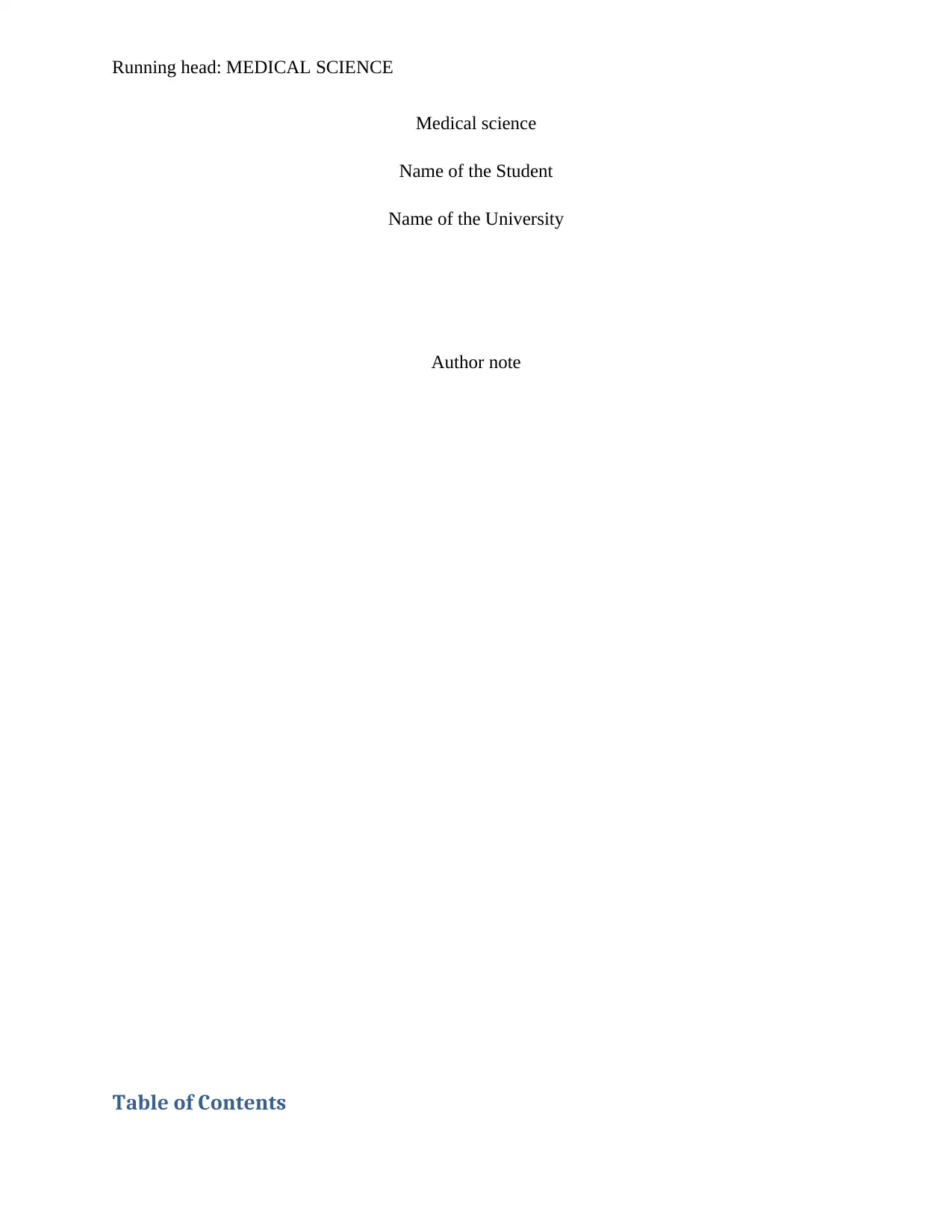
Running head: MEDICAL SCIENCE
Medical science
Name of the Student
Name of the University
Author note
Table of Contents
Medical science
Name of the Student
Name of the University
Author note
Table of Contents
Paraphrase This Document
Need a fresh take? Get an instant paraphrase of this document with our AI Paraphraser
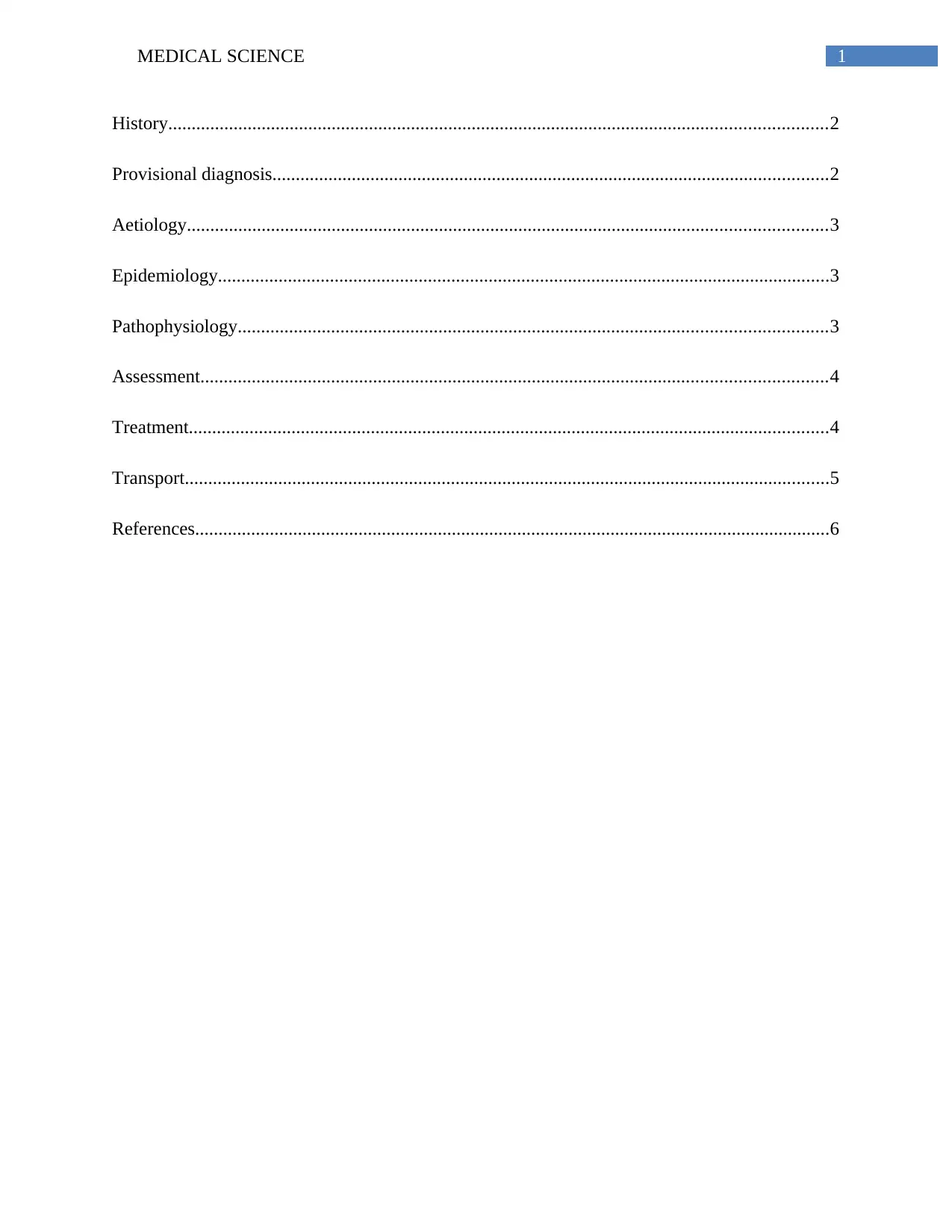
1MEDICAL SCIENCE
History.............................................................................................................................................2
Provisional diagnosis.......................................................................................................................2
Aetiology.........................................................................................................................................3
Epidemiology...................................................................................................................................3
Pathophysiology..............................................................................................................................3
Assessment......................................................................................................................................4
Treatment.........................................................................................................................................4
Transport..........................................................................................................................................5
References........................................................................................................................................6
History.............................................................................................................................................2
Provisional diagnosis.......................................................................................................................2
Aetiology.........................................................................................................................................3
Epidemiology...................................................................................................................................3
Pathophysiology..............................................................................................................................3
Assessment......................................................................................................................................4
Treatment.........................................................................................................................................4
Transport..........................................................................................................................................5
References........................................................................................................................................6
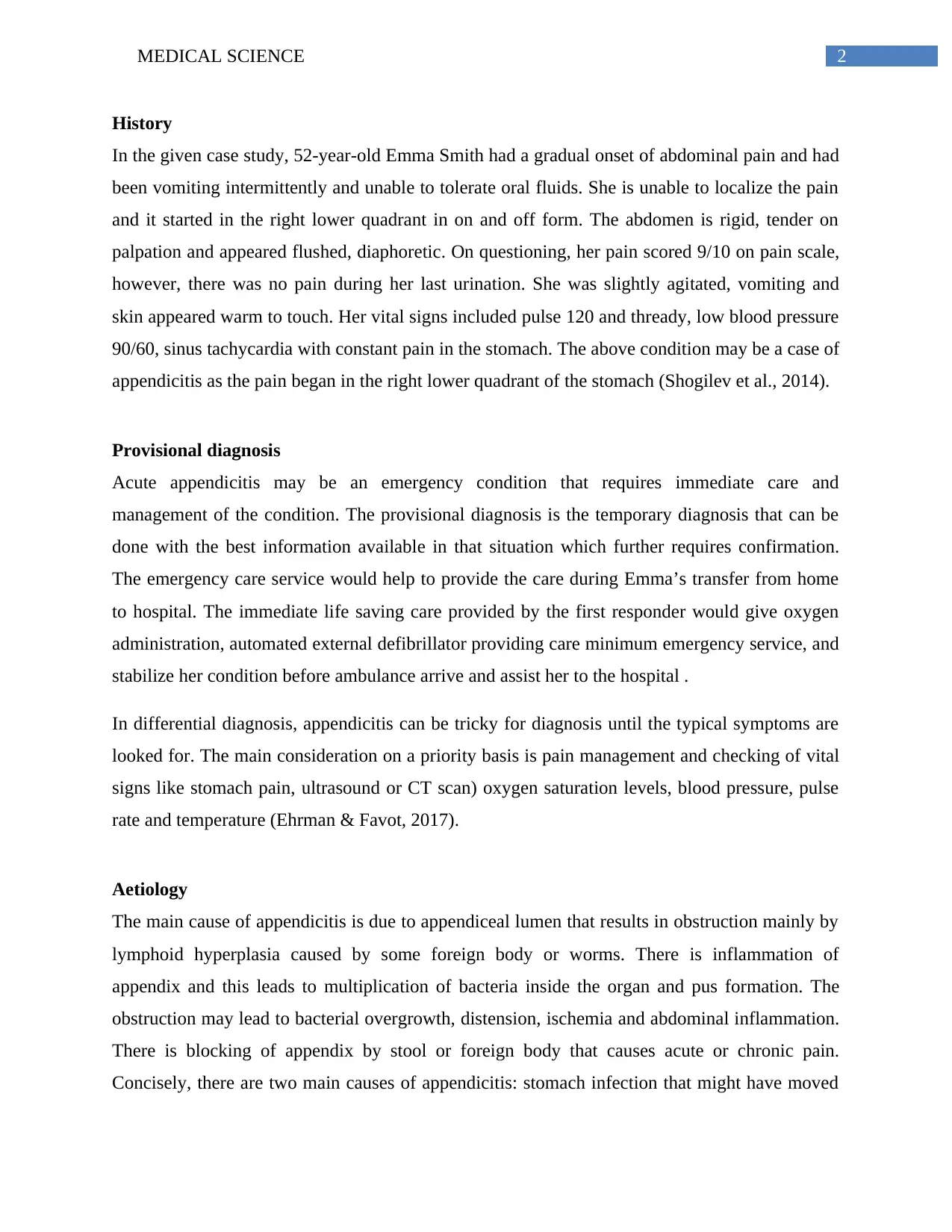
2MEDICAL SCIENCE
History
In the given case study, 52-year-old Emma Smith had a gradual onset of abdominal pain and had
been vomiting intermittently and unable to tolerate oral fluids. She is unable to localize the pain
and it started in the right lower quadrant in on and off form. The abdomen is rigid, tender on
palpation and appeared flushed, diaphoretic. On questioning, her pain scored 9/10 on pain scale,
however, there was no pain during her last urination. She was slightly agitated, vomiting and
skin appeared warm to touch. Her vital signs included pulse 120 and thready, low blood pressure
90/60, sinus tachycardia with constant pain in the stomach. The above condition may be a case of
appendicitis as the pain began in the right lower quadrant of the stomach (Shogilev et al., 2014).
Provisional diagnosis
Acute appendicitis may be an emergency condition that requires immediate care and
management of the condition. The provisional diagnosis is the temporary diagnosis that can be
done with the best information available in that situation which further requires confirmation.
The emergency care service would help to provide the care during Emma’s transfer from home
to hospital. The immediate life saving care provided by the first responder would give oxygen
administration, automated external defibrillator providing care minimum emergency service, and
stabilize her condition before ambulance arrive and assist her to the hospital .
In differential diagnosis, appendicitis can be tricky for diagnosis until the typical symptoms are
looked for. The main consideration on a priority basis is pain management and checking of vital
signs like stomach pain, ultrasound or CT scan) oxygen saturation levels, blood pressure, pulse
rate and temperature (Ehrman & Favot, 2017).
Aetiology
The main cause of appendicitis is due to appendiceal lumen that results in obstruction mainly by
lymphoid hyperplasia caused by some foreign body or worms. There is inflammation of
appendix and this leads to multiplication of bacteria inside the organ and pus formation. The
obstruction may lead to bacterial overgrowth, distension, ischemia and abdominal inflammation.
There is blocking of appendix by stool or foreign body that causes acute or chronic pain.
Concisely, there are two main causes of appendicitis: stomach infection that might have moved
History
In the given case study, 52-year-old Emma Smith had a gradual onset of abdominal pain and had
been vomiting intermittently and unable to tolerate oral fluids. She is unable to localize the pain
and it started in the right lower quadrant in on and off form. The abdomen is rigid, tender on
palpation and appeared flushed, diaphoretic. On questioning, her pain scored 9/10 on pain scale,
however, there was no pain during her last urination. She was slightly agitated, vomiting and
skin appeared warm to touch. Her vital signs included pulse 120 and thready, low blood pressure
90/60, sinus tachycardia with constant pain in the stomach. The above condition may be a case of
appendicitis as the pain began in the right lower quadrant of the stomach (Shogilev et al., 2014).
Provisional diagnosis
Acute appendicitis may be an emergency condition that requires immediate care and
management of the condition. The provisional diagnosis is the temporary diagnosis that can be
done with the best information available in that situation which further requires confirmation.
The emergency care service would help to provide the care during Emma’s transfer from home
to hospital. The immediate life saving care provided by the first responder would give oxygen
administration, automated external defibrillator providing care minimum emergency service, and
stabilize her condition before ambulance arrive and assist her to the hospital .
In differential diagnosis, appendicitis can be tricky for diagnosis until the typical symptoms are
looked for. The main consideration on a priority basis is pain management and checking of vital
signs like stomach pain, ultrasound or CT scan) oxygen saturation levels, blood pressure, pulse
rate and temperature (Ehrman & Favot, 2017).
Aetiology
The main cause of appendicitis is due to appendiceal lumen that results in obstruction mainly by
lymphoid hyperplasia caused by some foreign body or worms. There is inflammation of
appendix and this leads to multiplication of bacteria inside the organ and pus formation. The
obstruction may lead to bacterial overgrowth, distension, ischemia and abdominal inflammation.
There is blocking of appendix by stool or foreign body that causes acute or chronic pain.
Concisely, there are two main causes of appendicitis: stomach infection that might have moved
⊘ This is a preview!⊘
Do you want full access?
Subscribe today to unlock all pages.

Trusted by 1+ million students worldwide
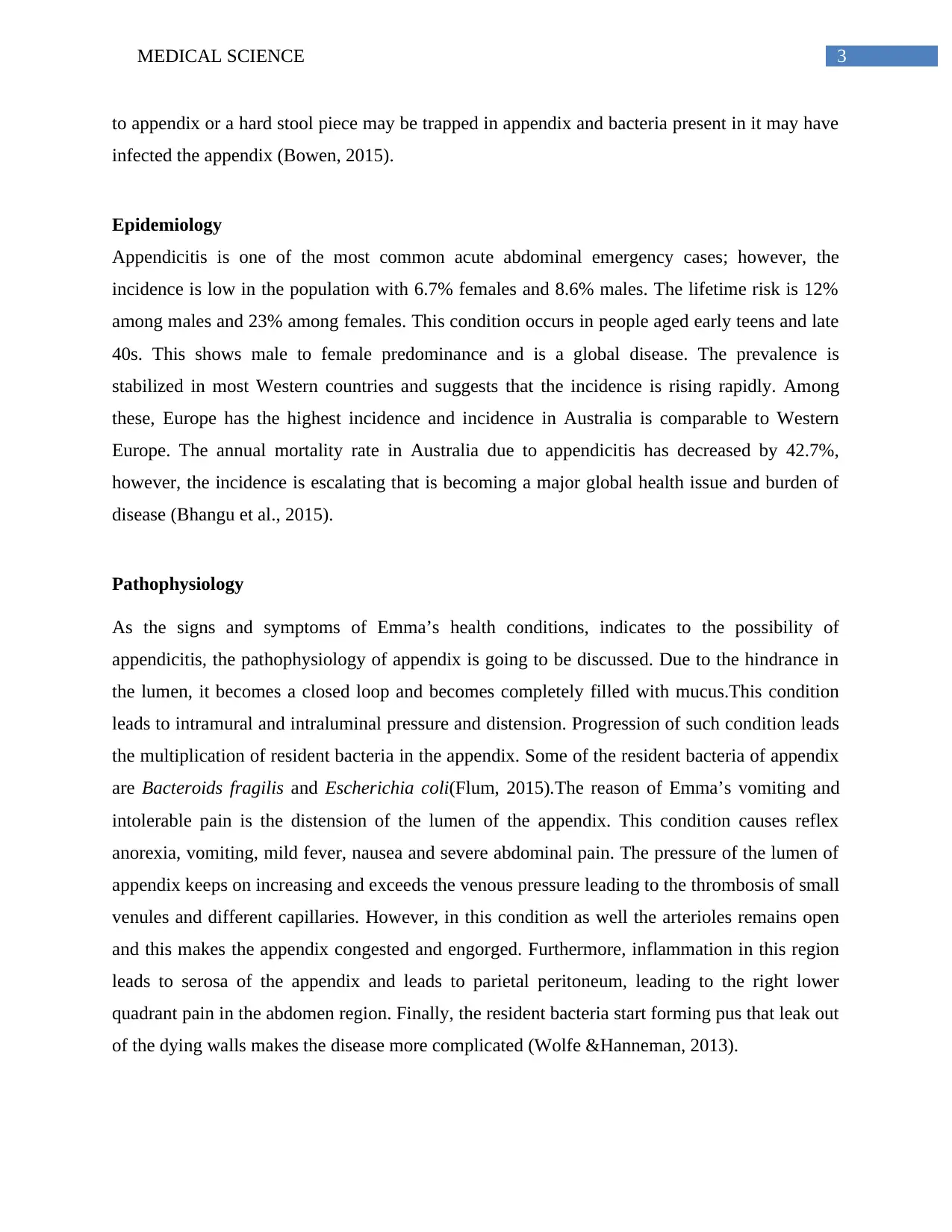
3MEDICAL SCIENCE
to appendix or a hard stool piece may be trapped in appendix and bacteria present in it may have
infected the appendix (Bowen, 2015).
Epidemiology
Appendicitis is one of the most common acute abdominal emergency cases; however, the
incidence is low in the population with 6.7% females and 8.6% males. The lifetime risk is 12%
among males and 23% among females. This condition occurs in people aged early teens and late
40s. This shows male to female predominance and is a global disease. The prevalence is
stabilized in most Western countries and suggests that the incidence is rising rapidly. Among
these, Europe has the highest incidence and incidence in Australia is comparable to Western
Europe. The annual mortality rate in Australia due to appendicitis has decreased by 42.7%,
however, the incidence is escalating that is becoming a major global health issue and burden of
disease (Bhangu et al., 2015).
Pathophysiology
As the signs and symptoms of Emma’s health conditions, indicates to the possibility of
appendicitis, the pathophysiology of appendix is going to be discussed. Due to the hindrance in
the lumen, it becomes a closed loop and becomes completely filled with mucus.This condition
leads to intramural and intraluminal pressure and distension. Progression of such condition leads
the multiplication of resident bacteria in the appendix. Some of the resident bacteria of appendix
are Bacteroids fragilis and Escherichia coli(Flum, 2015).The reason of Emma’s vomiting and
intolerable pain is the distension of the lumen of the appendix. This condition causes reflex
anorexia, vomiting, mild fever, nausea and severe abdominal pain. The pressure of the lumen of
appendix keeps on increasing and exceeds the venous pressure leading to the thrombosis of small
venules and different capillaries. However, in this condition as well the arterioles remains open
and this makes the appendix congested and engorged. Furthermore, inflammation in this region
leads to serosa of the appendix and leads to parietal peritoneum, leading to the right lower
quadrant pain in the abdomen region. Finally, the resident bacteria start forming pus that leak out
of the dying walls makes the disease more complicated (Wolfe &Hanneman, 2013).
to appendix or a hard stool piece may be trapped in appendix and bacteria present in it may have
infected the appendix (Bowen, 2015).
Epidemiology
Appendicitis is one of the most common acute abdominal emergency cases; however, the
incidence is low in the population with 6.7% females and 8.6% males. The lifetime risk is 12%
among males and 23% among females. This condition occurs in people aged early teens and late
40s. This shows male to female predominance and is a global disease. The prevalence is
stabilized in most Western countries and suggests that the incidence is rising rapidly. Among
these, Europe has the highest incidence and incidence in Australia is comparable to Western
Europe. The annual mortality rate in Australia due to appendicitis has decreased by 42.7%,
however, the incidence is escalating that is becoming a major global health issue and burden of
disease (Bhangu et al., 2015).
Pathophysiology
As the signs and symptoms of Emma’s health conditions, indicates to the possibility of
appendicitis, the pathophysiology of appendix is going to be discussed. Due to the hindrance in
the lumen, it becomes a closed loop and becomes completely filled with mucus.This condition
leads to intramural and intraluminal pressure and distension. Progression of such condition leads
the multiplication of resident bacteria in the appendix. Some of the resident bacteria of appendix
are Bacteroids fragilis and Escherichia coli(Flum, 2015).The reason of Emma’s vomiting and
intolerable pain is the distension of the lumen of the appendix. This condition causes reflex
anorexia, vomiting, mild fever, nausea and severe abdominal pain. The pressure of the lumen of
appendix keeps on increasing and exceeds the venous pressure leading to the thrombosis of small
venules and different capillaries. However, in this condition as well the arterioles remains open
and this makes the appendix congested and engorged. Furthermore, inflammation in this region
leads to serosa of the appendix and leads to parietal peritoneum, leading to the right lower
quadrant pain in the abdomen region. Finally, the resident bacteria start forming pus that leak out
of the dying walls makes the disease more complicated (Wolfe &Hanneman, 2013).
Paraphrase This Document
Need a fresh take? Get an instant paraphrase of this document with our AI Paraphraser
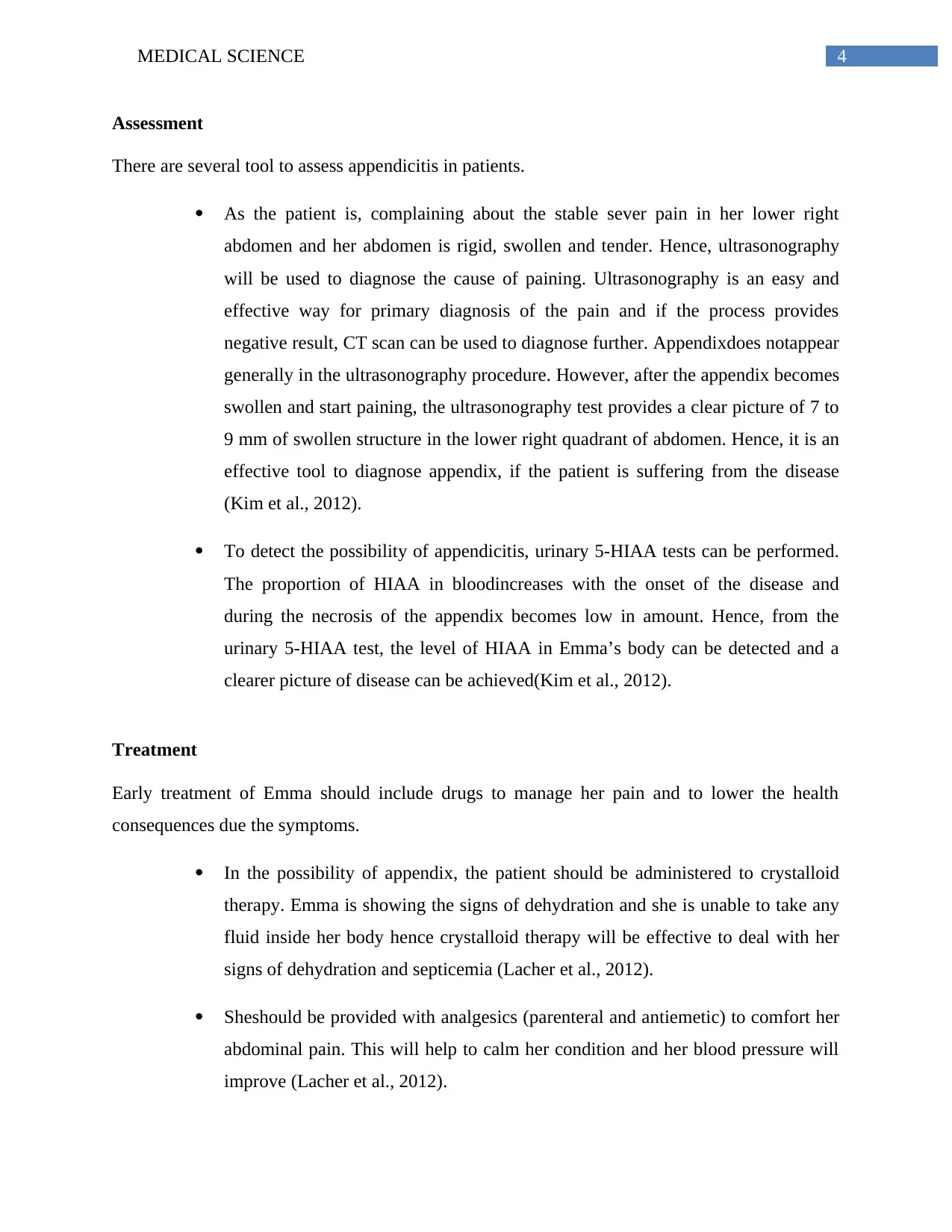
4MEDICAL SCIENCE
Assessment
There are several tool to assess appendicitis in patients.
As the patient is, complaining about the stable sever pain in her lower right
abdomen and her abdomen is rigid, swollen and tender. Hence, ultrasonography
will be used to diagnose the cause of paining. Ultrasonography is an easy and
effective way for primary diagnosis of the pain and if the process provides
negative result, CT scan can be used to diagnose further. Appendixdoes notappear
generally in the ultrasonography procedure. However, after the appendix becomes
swollen and start paining, the ultrasonography test provides a clear picture of 7 to
9 mm of swollen structure in the lower right quadrant of abdomen. Hence, it is an
effective tool to diagnose appendix, if the patient is suffering from the disease
(Kim et al., 2012).
To detect the possibility of appendicitis, urinary 5-HIAA tests can be performed.
The proportion of HIAA in bloodincreases with the onset of the disease and
during the necrosis of the appendix becomes low in amount. Hence, from the
urinary 5-HIAA test, the level of HIAA in Emma’s body can be detected and a
clearer picture of disease can be achieved(Kim et al., 2012).
Treatment
Early treatment of Emma should include drugs to manage her pain and to lower the health
consequences due the symptoms.
In the possibility of appendix, the patient should be administered to crystalloid
therapy. Emma is showing the signs of dehydration and she is unable to take any
fluid inside her body hence crystalloid therapy will be effective to deal with her
signs of dehydration and septicemia (Lacher et al., 2012).
Sheshould be provided with analgesics (parenteral and antiemetic) to comfort her
abdominal pain. This will help to calm her condition and her blood pressure will
improve (Lacher et al., 2012).
Assessment
There are several tool to assess appendicitis in patients.
As the patient is, complaining about the stable sever pain in her lower right
abdomen and her abdomen is rigid, swollen and tender. Hence, ultrasonography
will be used to diagnose the cause of paining. Ultrasonography is an easy and
effective way for primary diagnosis of the pain and if the process provides
negative result, CT scan can be used to diagnose further. Appendixdoes notappear
generally in the ultrasonography procedure. However, after the appendix becomes
swollen and start paining, the ultrasonography test provides a clear picture of 7 to
9 mm of swollen structure in the lower right quadrant of abdomen. Hence, it is an
effective tool to diagnose appendix, if the patient is suffering from the disease
(Kim et al., 2012).
To detect the possibility of appendicitis, urinary 5-HIAA tests can be performed.
The proportion of HIAA in bloodincreases with the onset of the disease and
during the necrosis of the appendix becomes low in amount. Hence, from the
urinary 5-HIAA test, the level of HIAA in Emma’s body can be detected and a
clearer picture of disease can be achieved(Kim et al., 2012).
Treatment
Early treatment of Emma should include drugs to manage her pain and to lower the health
consequences due the symptoms.
In the possibility of appendix, the patient should be administered to crystalloid
therapy. Emma is showing the signs of dehydration and she is unable to take any
fluid inside her body hence crystalloid therapy will be effective to deal with her
signs of dehydration and septicemia (Lacher et al., 2012).
Sheshould be provided with analgesics (parenteral and antiemetic) to comfort her
abdominal pain. This will help to calm her condition and her blood pressure will
improve (Lacher et al., 2012).
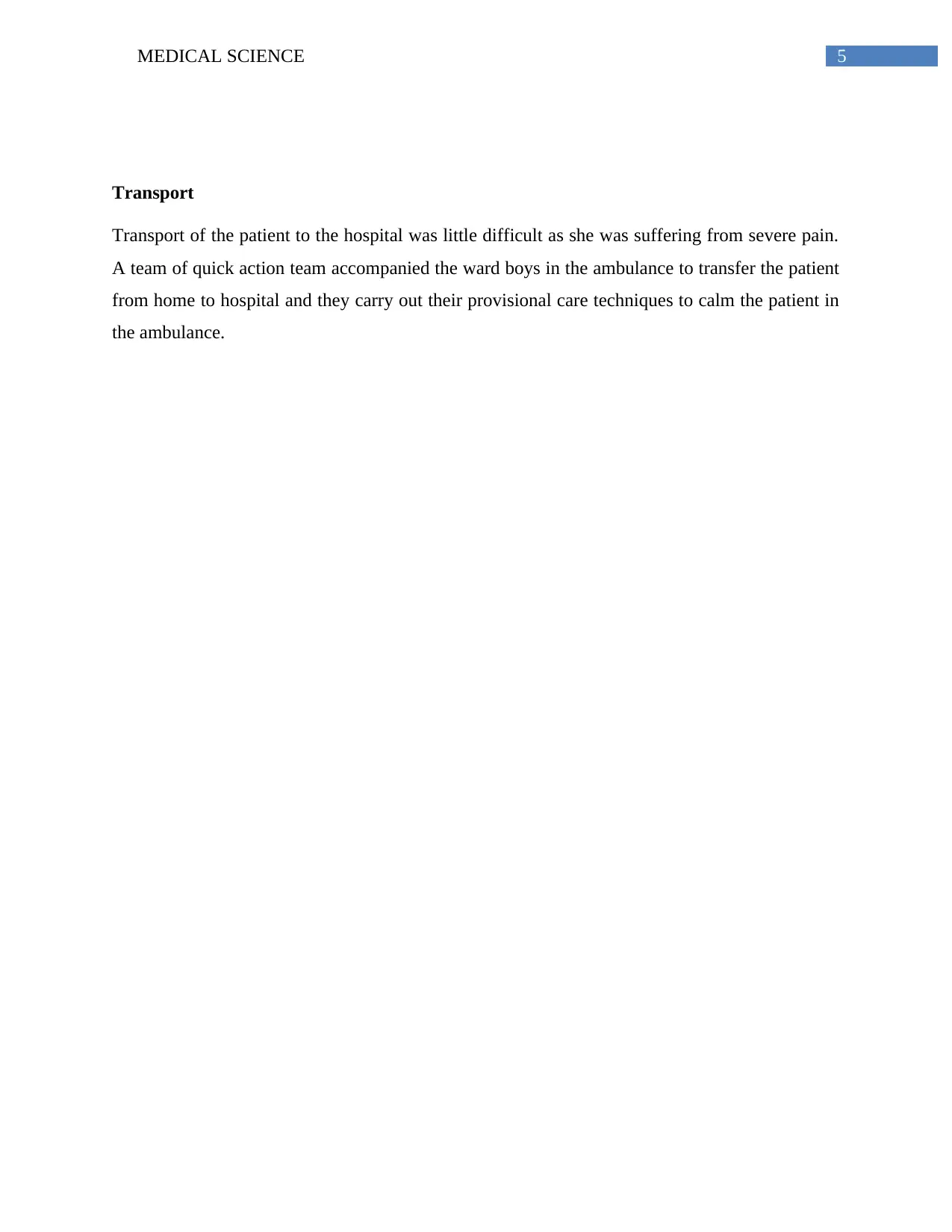
5MEDICAL SCIENCE
Transport
Transport of the patient to the hospital was little difficult as she was suffering from severe pain.
A team of quick action team accompanied the ward boys in the ambulance to transfer the patient
from home to hospital and they carry out their provisional care techniques to calm the patient in
the ambulance.
Transport
Transport of the patient to the hospital was little difficult as she was suffering from severe pain.
A team of quick action team accompanied the ward boys in the ambulance to transfer the patient
from home to hospital and they carry out their provisional care techniques to calm the patient in
the ambulance.
⊘ This is a preview!⊘
Do you want full access?
Subscribe today to unlock all pages.

Trusted by 1+ million students worldwide
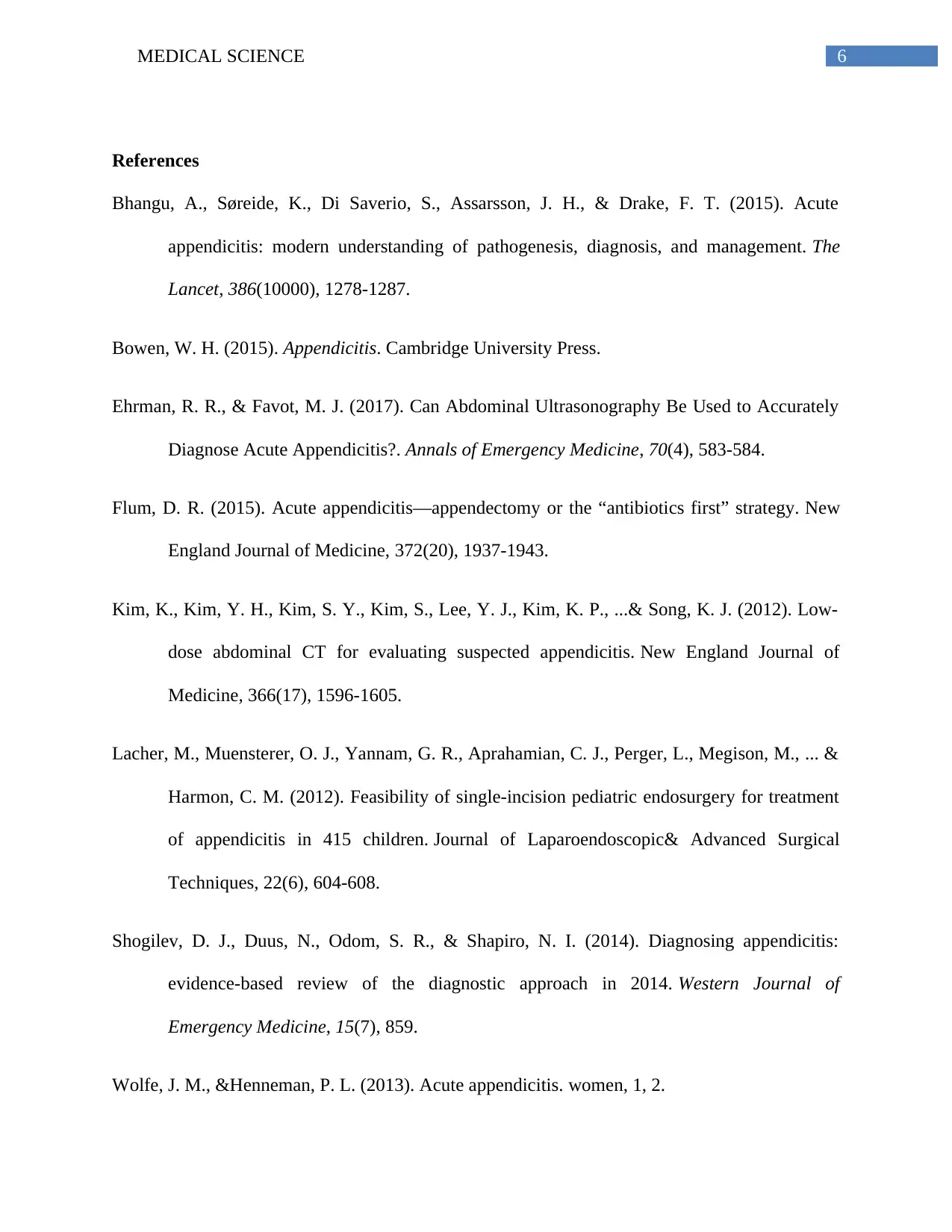
6MEDICAL SCIENCE
References
Bhangu, A., Søreide, K., Di Saverio, S., Assarsson, J. H., & Drake, F. T. (2015). Acute
appendicitis: modern understanding of pathogenesis, diagnosis, and management. The
Lancet, 386(10000), 1278-1287.
Bowen, W. H. (2015). Appendicitis. Cambridge University Press.
Ehrman, R. R., & Favot, M. J. (2017). Can Abdominal Ultrasonography Be Used to Accurately
Diagnose Acute Appendicitis?. Annals of Emergency Medicine, 70(4), 583-584.
Flum, D. R. (2015). Acute appendicitis—appendectomy or the “antibiotics first” strategy. New
England Journal of Medicine, 372(20), 1937-1943.
Kim, K., Kim, Y. H., Kim, S. Y., Kim, S., Lee, Y. J., Kim, K. P., ...& Song, K. J. (2012). Low-
dose abdominal CT for evaluating suspected appendicitis. New England Journal of
Medicine, 366(17), 1596-1605.
Lacher, M., Muensterer, O. J., Yannam, G. R., Aprahamian, C. J., Perger, L., Megison, M., ... &
Harmon, C. M. (2012). Feasibility of single-incision pediatric endosurgery for treatment
of appendicitis in 415 children. Journal of Laparoendoscopic& Advanced Surgical
Techniques, 22(6), 604-608.
Shogilev, D. J., Duus, N., Odom, S. R., & Shapiro, N. I. (2014). Diagnosing appendicitis:
evidence-based review of the diagnostic approach in 2014. Western Journal of
Emergency Medicine, 15(7), 859.
Wolfe, J. M., &Henneman, P. L. (2013). Acute appendicitis. women, 1, 2.
References
Bhangu, A., Søreide, K., Di Saverio, S., Assarsson, J. H., & Drake, F. T. (2015). Acute
appendicitis: modern understanding of pathogenesis, diagnosis, and management. The
Lancet, 386(10000), 1278-1287.
Bowen, W. H. (2015). Appendicitis. Cambridge University Press.
Ehrman, R. R., & Favot, M. J. (2017). Can Abdominal Ultrasonography Be Used to Accurately
Diagnose Acute Appendicitis?. Annals of Emergency Medicine, 70(4), 583-584.
Flum, D. R. (2015). Acute appendicitis—appendectomy or the “antibiotics first” strategy. New
England Journal of Medicine, 372(20), 1937-1943.
Kim, K., Kim, Y. H., Kim, S. Y., Kim, S., Lee, Y. J., Kim, K. P., ...& Song, K. J. (2012). Low-
dose abdominal CT for evaluating suspected appendicitis. New England Journal of
Medicine, 366(17), 1596-1605.
Lacher, M., Muensterer, O. J., Yannam, G. R., Aprahamian, C. J., Perger, L., Megison, M., ... &
Harmon, C. M. (2012). Feasibility of single-incision pediatric endosurgery for treatment
of appendicitis in 415 children. Journal of Laparoendoscopic& Advanced Surgical
Techniques, 22(6), 604-608.
Shogilev, D. J., Duus, N., Odom, S. R., & Shapiro, N. I. (2014). Diagnosing appendicitis:
evidence-based review of the diagnostic approach in 2014. Western Journal of
Emergency Medicine, 15(7), 859.
Wolfe, J. M., &Henneman, P. L. (2013). Acute appendicitis. women, 1, 2.
1 out of 7
Related Documents
Your All-in-One AI-Powered Toolkit for Academic Success.
+13062052269
info@desklib.com
Available 24*7 on WhatsApp / Email
![[object Object]](/_next/static/media/star-bottom.7253800d.svg)
Unlock your academic potential
Copyright © 2020–2025 A2Z Services. All Rights Reserved. Developed and managed by ZUCOL.





